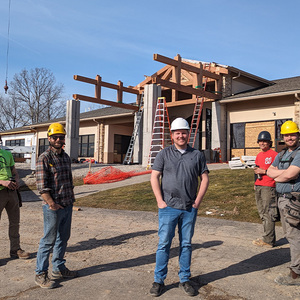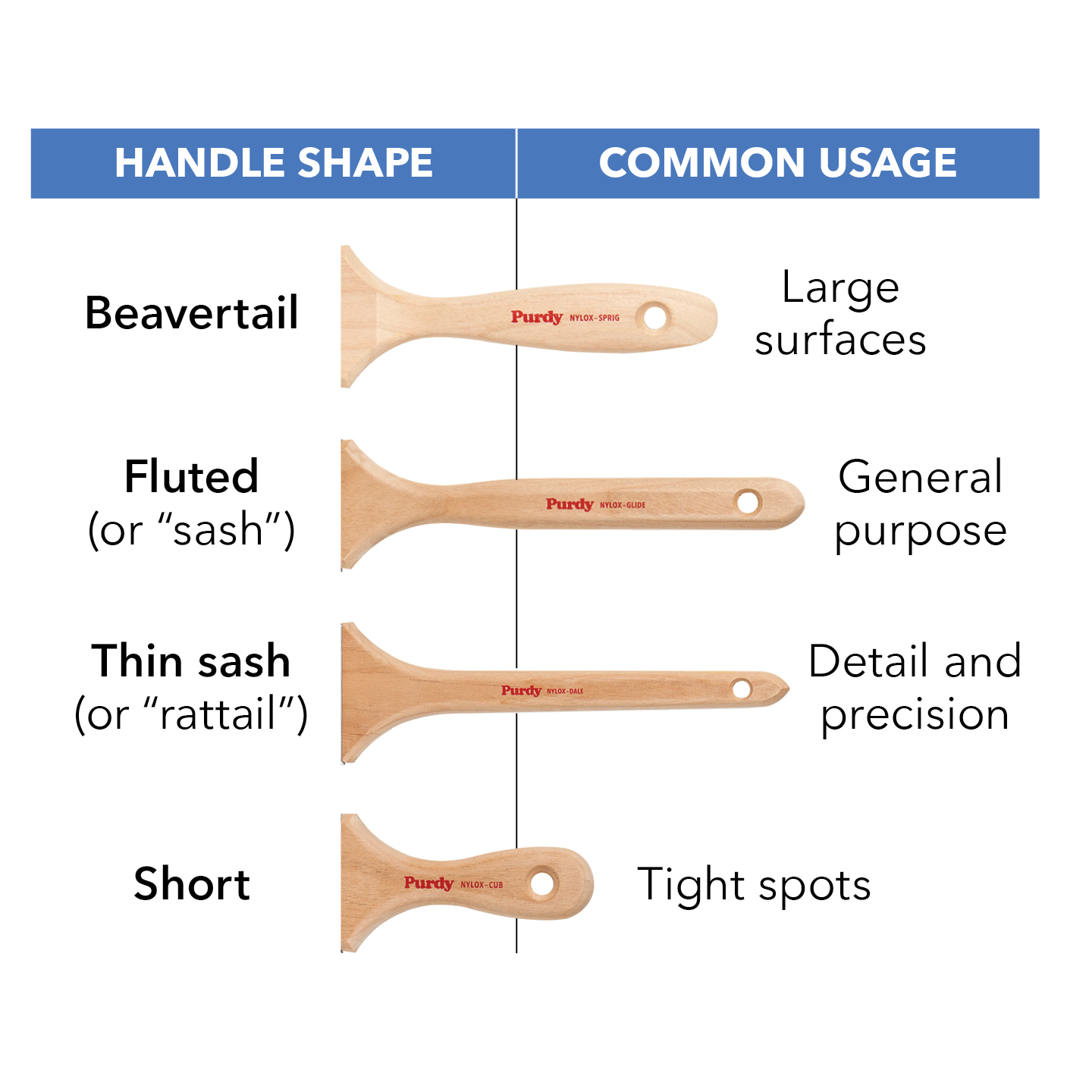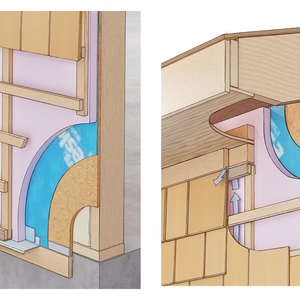*
Help! Was reading the other metal roof installation discussion. Do I understand that a metal roof should not go over OSB sheathing? Our contractor is just finishing up the trusses on house…has already trussed and sheathed garage. I have a feeling it’s another one of those “we’ve always done it that way” situations. Should we tell him not to sheath? If no sheathing, what?
Discussion Forum
Discussion Forum
Up Next
Video Shorts
Featured Story

Old masonry may look tough, but the wrong mortar can destroy it—here's how to choose the right mix for lasting repairs.
Highlights
"I have learned so much thanks to the searchable articles on the FHB website. I can confidently say that I expect to be a life-long subscriber." - M.K.
Fine Homebuilding Magazine
- Home Group
- Antique Trader
- Arts & Crafts Homes
- Bank Note Reporter
- Cabin Life
- Cuisine at Home
- Fine Gardening
- Fine Woodworking
- Green Building Advisor
- Garden Gate
- Horticulture
- Keep Craft Alive
- Log Home Living
- Military Trader/Vehicles
- Numismatic News
- Numismaster
- Old Cars Weekly
- Old House Journal
- Period Homes
- Popular Woodworking
- Script
- ShopNotes
- Sports Collectors Digest
- Threads
- Timber Home Living
- Traditional Building
- Woodsmith
- World Coin News
- Writer's Digest


















Replies
*
Tina , the osb on the house will make the roof quieter , help with the condensation problem on most unsheathed roofs
*The sheathing is not required structurally and therefore it is an over-build and over-spend -- unless your insulating between the top cord of the trusses and need a top deck to attach and/or contain the insulation -- unlikely with trusses. The top edge of your trusses can be strapped with 1X3's as horizontal plates across which the steel is screwed.Your builder will probably say the sheathing is necessary for weather proofing the roof. I would insist on the lightest material available since it has no structural function at all in this application. There are other, less expensive ways to weatherproof the cavity but may not be aesthetically pleasing to you; ie, Tu Tuf or Par Pac or a polyester reinforced radiant/moisture barrier like Radiantec's products.What ever you decide re: the above, don't screw the steel directly against the sheathing. This creates the capillary sandwich discussed in the other thread. Water will be sandwiched between the two adjacent surfaces and stay there a long time, attracting more water into the space. Roofing felt is a must if your builder doesn't plan to horizontally strap the sheathing to separate the steel from the OSB. OSB and plywood are sponges in this situation and love to rot. You will not prevent the problem by using exterior grade sheathing which is another unnecessary expense in most above ground applications. Also, screwing steel into wood makes for condensation puncture points that rot around the screw shank and invite the wind to rip the screws out of the roof.
*TinaDitto Tedd's post.Steel is a more expensive roofing material per square than any other, but it more than pays for itself in life span. However, thei real saving comes when you don't need to sheath the roof. And you b don'tneed to sheath the roof!!!The difference in price between a 4x8 sheet of OSB or ply and 8 pieces of 1x4x8 (for exmple)is big. . . the time saved in humping edless 4x8 sheets up onto the roof, nailing them off, and creating staging areas to work from is b huge!!As you install the strapping/purlins at 24"oc you are creating a permanent roof ladder to climb up and down whilst installing the steel. Only the last sheet requires extra attention.If your builder new what a thrill it is to work on this kind of roof he would voluntarily pack in sheathing, and never mention it again in the same breath with steel roofing!!!-pm
*I am wonderin' what kind of fasteners will reliably hold a steel roof to 1/2" OSB. That has been my question throughout these discussions. - jb
*Some standing seam roofing manufacturers normally REQUIRE solid sheathing under their architectural-type standing seam panels for a guarantee. It's an appearance problem, and can cause litigation. BHP is one supplier I've had experience with.The problem is "telegraphing" of the purlins. For example, when some lead-footed mechanical contractor walks all over it. Under the right conditions, rib spacing, clip height, and panel gage, a foot coming down at the center of the panel causes a slight crease as it comes accross the purlin.I certainly agree that the best use for metal panels is the economical situation where it replaces wood framing and sheathing as an integrated system made of steel. However, more and more, steel roofing is being used for style and appearance regardless of cost. And these clients are often very particular about any appearance defects. Perhaps this is why manufacturers are shy about things like oil canning, telegraphing, low slope, scratches etc.Gary Wheeler, AIA
*Gary -- we're using BHP roofing, and before getting to your post, I read their installation instructions...and they do say to use sheathing and felt. So the bottom line is, do I try to re-educate our contractor and save money (which is REALLY important as we're over budget (surprise, surprise)), or will we be compromising any warranty with BHP on the roof? I don't care how it looks (within reason, obviously) as long as it's structurally sound and weathertight. Way out here, no one's going to see the roof anyway.We've had some difficulty with contractor already on other things (like housewrap put inside sheathing), so don't want to create more problems. If he insists on sheathing, is there something less expensive that will provide the "weatherproof" he may want? TEDD - What are TuTuf, Par Pac? And the Radiantec products, are they like fabric sheet radiant barriers. Maybe I should go find Radiantec on web, since it's a rainy day today...
*Gary et alI forgot to qualify the fact that I don't have access/experience with some of the steel roof products you have in the States.I have yet to install a steel roof where appearance and style were not a factor. I use the heavier 26 guage, higher rib, for residential. Even though it is actually a tarted up i ag panelit still comes with touch up paint, and is delivered carefully packaged with "cover sheets" of the same product(I have quite a collection of various lengths and colours covering my wood pile).I did a leaky chimney repair on someone elses install a year or so ago, and they used a thinner guage steel and it did feel quite flimsy to walk on.-pm
*Sheathing may be required structurally for the roof diaphram. Many engineers will no longer approve an unsheathed roof. In Calif. a sheathing edge cannot come within 16" of the ridge and the sheathing must be nailed to the ridge.
*As far as fasteners go, I would put my money on screwing into purlins long before I would screw into OSB or plywood. Laminates will not hold a screw a tight as softwood lumber. I know this from experience but I am sure there are some people on this site who actually hve the numbers on holding power/grip in these different materials. Wet laminates eventually separate layer by layer and condensation cycles plus metal screws penetrating the sheathing will break down glues and therefore weaken holding strength. Wet/dry cycles mean laminates shrink back from fasteners and open up the holes around them. I prefer laminates for their vertical shear strength (walls)but not for upward lift conditions like a roof.Earlier posts in Breaktime have exchanged facts on regional code and engineering specs because of variances in geological conditions (ie; earthquake zones). California is more rigid in the requirement for structural shear strength requiring either bracing or sheathing in walls. I don't know about the roof but I guess this is a logical extension. Check regional code requirements. By raising this issue you are really challenging even more fundamental structural assumptions; like, why use stud framing at all? I think if you check the California Codes, you would find that purlins with trusses well exceed the engineering requirements and that this configuration will satisfy the specs (racking and bending loads) as easily (and a lot less expensively) as sheathing. As in the other thread, I suggest getting some AWPI booklets on engineered purlin roofs.
*Tina if I remember right you are almost 2 miles above sea level in New Mexico. I'll be very surprised if moisture builds up in your roof. You probably get more precipitation than the flat landers but, It probably is still a dry enviroment. Metal roofs are going up like crazy in the Pacific Northwest on top of sheeting.Joe
*Joe. Yes, we're way up there. We don't get alot of moisture (except for this summer, when we've had 14+ inches since June -- more than average annual precip). But when it does come, it comes hard, including hail. Also WIDE temperature variations during day. Can be subzero at night, 60's or 70's during day. My main concern, besides overbuilding, is, since we're not using a roof with hidden clips/fasteners, whether fasterners/washers will wear and loosen with all that expansion/contraction and then allow moisture in.
*Joe - have you done any of these roofs yourself? If so, what kind of sheathing and what kind of fasteners? Thanks - jb
*Tina,I'm in the same boat. I'm designing my own house and want to use metal roofing. I've talked to installation gurus at ATAS, Custom-bilt, Fabral, McElroy and others. Nobody wants to give me the tried and true method for a drip-free installation over purlins. They do all insist that decking NOT BE OSB for all the reasons others have mentioned. Decking must be ply. I can't afford to deck with 5/8 or 3/4 ply and pay upwards of $150 a square for structural panels. I also disagree with the long term soundness of felt over purlins (won't it sag and rip over time?) and of the incredible installation nightmare this would be (either felt as you go with multiple rolls going to respect seams or felt it all and WATCH your step!). I won't go ahead myself until I talk to someone who sleeps in a house with structural panels over purlins! Like Red Green says, we're all in this together, I'm pulling for ya....
*Replies to Tina and Crazy Legs,I've used a 12" coverage `ziplock' galvanised and factory painted roofing to cover 2 roofs in the last 14 months. The first one is my cabin in Alaska which is open frame on the inside at this time. It is framed with 2 X 10 #3 and btr D-Fir on 24" centers and sheated with 5/8, 8" O.C., T-1-11. The sheeting is hand nailed with high quality 8d hot dip galvy box nails and felted with #15 ASTM felt. The concealed ziplock fastners are a #10 or #12 X 1-1/8" waferhead electro galvanised screw supplied by Morth American Metal Inc. in Hillsboro OR. These screws were installed on 16" centers. This roof is a 16/12 gable with back to back 10/12 dormers in the center of the roof. Probably this could be called a cross-gable roof because of the equal ridge heighths. Perhaps moisture can build up in between the felt and metal. If moisture can build up any where, it can buld up here. This cabin is 60' above sealevel, surrounded by old growth trees, receives very, very little direct sunlight, and gets 12 to 18' of snow every year. I'm not sure what the annual rainfall there is but it must be in excess of 40". I made my choices there, it will take years to figure out how good they were. By the way I paid $5 a sheet for the T-1-11 and $.10 per bd' for the D-fir. I love that roof. Sorry for the long winded stuff but, perhaps it will answer your next question. The other roof was a big reroof of a ranch house outside of Portland. Here the pitch was 2/12 and the same roofing, felt and fastners were used. Because this was a reroof it went over sheeting. I would be more concerned about water entrapment with exposed fastners especially in an enviroment with the extreme temperture and humidity ranges of Lisa's home. My wife calls I'll talk to you again soon.Joe
*Aaron - have you considered buying 5/8" plywood to build your own concrete forms with, then using the same plywood to sheet your roof with? It might pencil out better than you think. - jb
*Now you're talkin'. I would have a lot more faith in screwin' into 5/8 T- 111 than into any CDX (absolutely no faith screwin' into OSB of any thickness) - jb
*It has been well known for over 50 years that screws will not hold in OSB or plywood, but the people who stand to make money off of concealing the truth have not let it out that roofing nails will not hold either. One solution to this to apply all roofing over skip sheeting. 1x is not acceptable since it has a tendency to split. 2x is ok but is best applied on edge so that the roofing nails go into the long dimension. It is also possible to nail only over the framing members. This must be done with at least a 3" nail. Composition shingles over skip sheeting produce kind of a wavy effect, but I have found that leaking is not a problem if the pitch is at least 6.275 in 10. Another solution which works is to clinch all the roofing nails from underneath after the roof is applied. 2" minimum nails should be used. This does not work well with screws since they don't bend as easily as nails, so if you prefer screws it is necessary to use machine screws. Drill through the roofing and have a helper in the attic apply nuts and lock washers to the screws. In warm climates or during the summer this cannot be done in unvented attics during the day, so be sure to allow lots of attic ventilation. Omitting gable end covering altogether should be adequate.We also use an inverted roof system, where the insulation is applied over the roofing to hold it down. This works especially well with fiberglass, since when it gets full of water it is very heavy and unlikely to blow off. Foam insulation can be nailed direclty through the roofing into the framing making nailing into the sheeting unnecessary. This even makes sheeting unnecessary, so it can be eliminated.Another system that can be used to avoid nailing into the sheeting was developed in the south west. This is called the New Mexico system and uses blue tarps balasted with old tires. This is a very inexpensive system and has been proven over many years.
*Babe - About this NM system, will a green tarp work, in a pinch? - jb
*6.275 in 10. Is this metric?
*Nah. ..ballpark lingo, yah know?
*Proper metric terminology for this pitch would be .6275. I called this 6.275 in 10 so as not to confuse those of you who are used to expressing pitches as so-much in 12. Expressions of this kind are too close to being fractions which are prohibited in the metric system as is the number 12. 12 = 2x2x3. Since 1/3 cannot be expressed as a decimal, the number 3 and all of its multiples are not used in the metric system which must use decimals. Irrational numbers are not allowed either. It was originally thought that metric pi could be set at 3, but since 3 is not used, metric pi is set at 2.995. As everyone knows a circle has both a diameter and a circumfrence. You can easily draw a circle with a compass. If pi were truely irrational it would be impossible to draw a circle with both a diameter and a circumfrence since an infinite amount of time would be required to make it accurate to all the infinite decimals of pi. Blue tarps are prefered, but a green tarp will do in a pinch. Silver tarps are of too high quality to make a cost efficient roof.
*So BabeWhat about roofing with that Too Tough stuff your always yappin about?? Which grade would you use, the Too Tough, Too F**kin Tough, or Really F**kin Tough??I hear the Really F**kin Tough is so f**kin tough that they're gonna start usin it on the Shuttle instead of those wimpy floor tiles that keep fallin off. Wrap the sucker, add a little red tape and Bob's yer f**kin uncle!!!regards-pm(s)
*I have a IMAGE II Residential Metal Roofing by Metal Sales Manufacting Corp. info pack in my hand it says """Metal roofing is typically installed over solid sheathing with felt paper utilizing just a few tools for quick installation."" I am going to ask them some more questions...about installation...Thankx steve
*Patrick, We need to trip all the breakers to the shop and share a few beers someday...always laughing,Mongo
*Patrick, your killin me man [LOL,LOL.LOL]